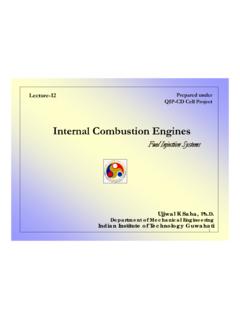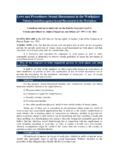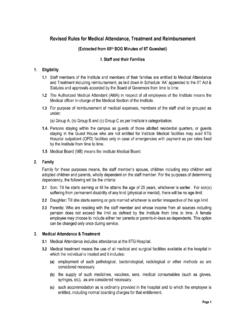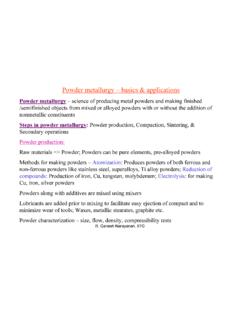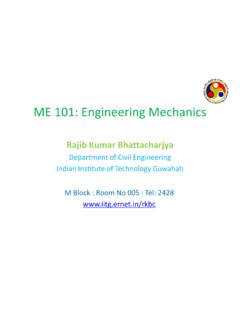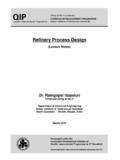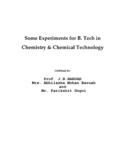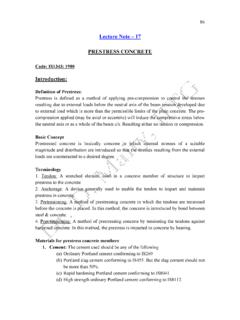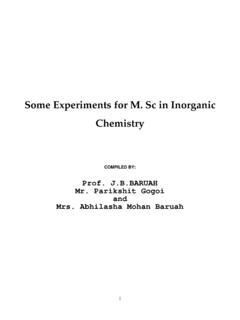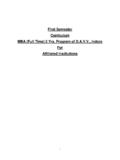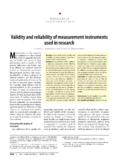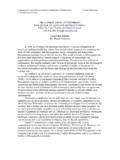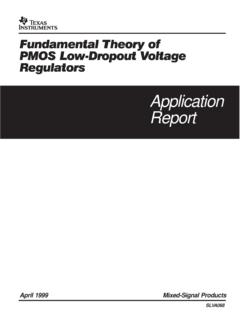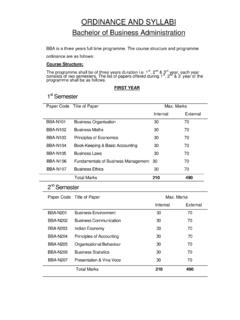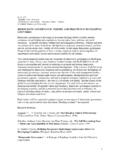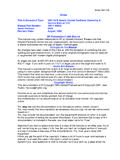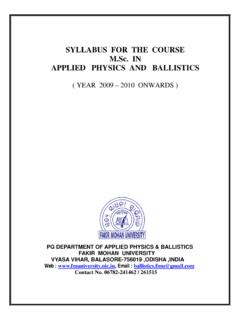Transcription of Internal Combustion Engines - iitg.ac.in
1 1 Internal Combustion EnginesLecture-6 UjjwalKSaha, of Mechanical EngineeringIndian Institute of Technology GuwahatiPrepared underQIP-CD Cell Project2 Crank shaft 90o180oBDCTDC0o270o Engine Operating CycleSpark plug for SI engineFuel injector for CI engineTop Center(TC)BottomCenter(BC)ValvesClearanc evolumeCylinder wallPistonStrokeCArevrevsCA 360 1 speedcrank anglescrank time ==3SI and CI Engines Spark ignition (SI): Combustion is initiated by spark air and fuel can be added together Compression ignition (CI): Combustion is initiated by auto ignition requires fuel injection to control ignition4 In spark ignition Engines , air and fuel are usually mixed prior to entry into the Mixing The ratio of mass flow of air to the mass flow of fuel must be held roughly constant at about 15 for proper Combustion . Conventionally, a mechanical device known as a carburetoris used to mix fuel and air. Most modern cars use electronic fuel-injectionsystems.
2 With diesel Engines , fuel is sprayed directly into the cylinders, and power is varied by metering the amount of fuel added(no throttle).5 The Net Work Output of a CycleThe Net Work Output of a Cycle8-5 The net work output of a cycle is equivalent to the product of the mean effect pressure and the displacement volume6 Power can be increased by increasing: the engine size,Vd compression ratio,rc engine speed, NIndicated Power7 Power Regulation An IC engine is basically an air engine, the more air you get into the cylinder, the more fuel you can burn, and more the power you < PatmIntake manifoldFuel Vary throttle position -Maximum intake pressure (and power) achieved at wide-open-throttle (WOT), and minimum at Combustion Engine9 Background on the Otto Cycle The Otto Cycle has four basic steps or strokes: An intake stroke that draws a combustible mixture of fuel and air into the cylinder.
3 A compression stroke with the valves closed which raises the temperature of the mixture. A spark ignites the mixture towards the end of this stroke. An expansion or power stroke, resulting from Combustion . An Exhaust stroke the pushes the burned contents out of the idealized representation of the Otto cycle on a PV and Ideal Cycles in Spark-Ignition Engines and Their P-vDiagramActual and Ideal Cycles in Spark-Ignition Engines and Their P-vDiagram8-611 Typical Theoretical P-V and Valve Timing Diagrams of a Four-Stroke Spark Ignition EngineObservations: P-V diagram shows sharp , valves open/close instantaneously at dead centres12 Actual Case: IV and EV open/close before and after dead centres9 Mechanical Factor9 Dynamic Factor of Gas Flow9 Valves are opened and closed by cam mechanism 9 Valves will bounce on its seat if closed abruptly9 Opening/closing of valves spread over a certain crank angle Every Corner in the P-V diagram is ROUNDED13 Actual Valve Timing Diagram of a Four-Stroke Spark Ignition Engine IV opens 200before TDC.
4 IV closes 350after BDC to take the advantage of momentum of rapidly moving gases (Ram Effect). Ignition occurs 350before TDC; this is to allow the time delay between the spark and commencement of Combustion . EV opens at 350before BDC; else pressure will rise enormously, and the work required to expel the gas will increase. EV closes at 100after TDC; this is to increase the volumetric HIGH SPEED Engines , higher values of anglesare desirable to take into account the short time Overlap: The time during which both the valves (inlet and exhaust) remain open at the same values quoted in the actual valve timing diagrams are the typical values,and may vary from engine to IV opens before TDC and closes after BDC. This is arranged so as to get maximum charge inside the cylinder. When the IV opens, the charge outside the valve has to be accelerated upto the inlet velocity, and this takes time.
5 In order that maximum inlet velocity occurs at the earliest possible moment during the intake stroke, the IV is opened kinetic energy of the moving charge is used at the end of the intake stroke to produce a ramming effect by closing the IV slightly after BDC. The ramming effect thus increases the volumetric EV opens before BDC so as to exhaust the Combustion products efficiently. Thus, by virtue of its excess pressure above atmosphere, some exhaust gas leaves the cylinder. This makes the exhaust gas to flow freely from the cylinder by the time piston commences the exhaust , by closing the EV after TDC, the kinetic energy of the exhaust gas can be utilized to assist in maximum exhausting of the gas. In the process, the IV begins to open before the EV closes and this is called valve Timing for Low and High Speed Four-Stroke Spark Ignition Engines18 Sequence of Events in a Four-Stroke Spark Ignition Engine Pressure vs.
6 Crank Angle19p-V diagram of a Four Stroke SI Engine at WOTThe pressure at the intake port is just below atmospheric pressureThe upper loop consists of compression and power strokes and the area represents positive indicated work. The lower loop indicates negative work of the intake and exhaust stroke. This is called indicated pumping pressure at the intake port is significantly lower than atmospheric pressurePintakep-V diagram of a Four Stroke SI Engine at Part-ThrottleThe upper loop consists of compression and power strokes and the area represents positive indicated work. The lower loop indicates negative work of the intake and exhaust strokes. This is called indicated pumping diagram of a Four Stroke SI Engine with SuperchargerThe Engines with superchargers or turbochargers have intake pressures greater than the exhaust pressure, yielding a positive pump Theoretical and Actual p-V Diagrams of a Four-Stroke Compression Ignition Engine23 Actual Valve Timing Diagram of a Four-Stroke Compression Ignition Engine1.
7 TDC2. BDC3. IV opens at 250before TDC 4. IV closes at 300after BDC5. Fuel injection starts at 50 before TDC 6. Fuel injection closes at 250after TDC7. EV opens at 450 before BDC 8. EV closes at 150after TDC24 Summary Ideal and Actual p-V Diagram of a Four Stroke SI Engine25 Real vs. Ideal 4 Stroke SI Engine26 Summary Ideal and Actual Valve Timing Diagram of a Four Stroke SI Engine27 Valve Timing 4 Stroke SI EngineValve timing angles:Conventional Engines operate at low rpms, with idle and part load importantHigh performance Engines operate at high rpmsat WOT, with power and volumetric efficiency importantAt high engine speeds, less time available for fresh gas intake so need more crank angles to get high volumetric efficiency large valve overlapAt low engine speed and part throttle valve overlap is minimizedby reducing the angle duration for valves staying Valve Timingused to obtain optimum performance over wide WH, Crouse WH, andandAnglin DLAnglin DL, (1985),Automotive Engines ,Tata McGraw TD, Eastop TD, andandMcConkey A,McConkey A,(1993),Applied Thermodynamics for Engg.
8 Technologists, Addison CR, Fergusan CR, andandKirkpatrick ATKirkpatrick AT,,(2001), Internal Combustion Engines ,John Wiley & VGanesan V,,(2003), Internal Combustion Engines ,Tata McGraw PW, Smith JH, Gill PW, Smith JH, andandZiurys EJZiurys EJ,,(1959),Fundamentals of I. C. Engines ,Oxford and IBH Pub Ltd. H,Heisler H,(1999),Vehicle and Engine Technology,Arnold JB,Heywood JB,(1989), Internal Combustion Engine Fundamentals, McGraw JB, Heywood JB, andandSher E,Sher E,(1999),The Two-Stroke Cycle Engine, Taylor & R, Joel R, (1996),(1996),Basic Engineering Thermodynamics, ML, and Sharma RP,Mathur ML, and Sharma RP,(1994),A Course in Internal Combustion Engines ,Dhanpat Rai & Sons, New WW,Pulkrabek WW,(1997),Engineering Fundamentals of the I. C. Engine, Prentice GFC, Rogers GFC, andandMayhew YRMayhew YR, (1992), Engineering Thermodynamics,Addison Wisley. S,Srinivasan S,(2001),Automotive Engines ,Tata McGraw R,Stone R,(1992), Internal Combustion Engines , The Macmillan Press Limited, CF,Taylor CF,(1985),The Internal - Combustion Engine in Theory and Practice, & 2, The MIT Press, Cambridge, me429/lecture-air-cyc-web%5B1% ~kunrotc/academics/180/Lesson%2008% secondary/ ~yanchen/ME200 -Web Resources
